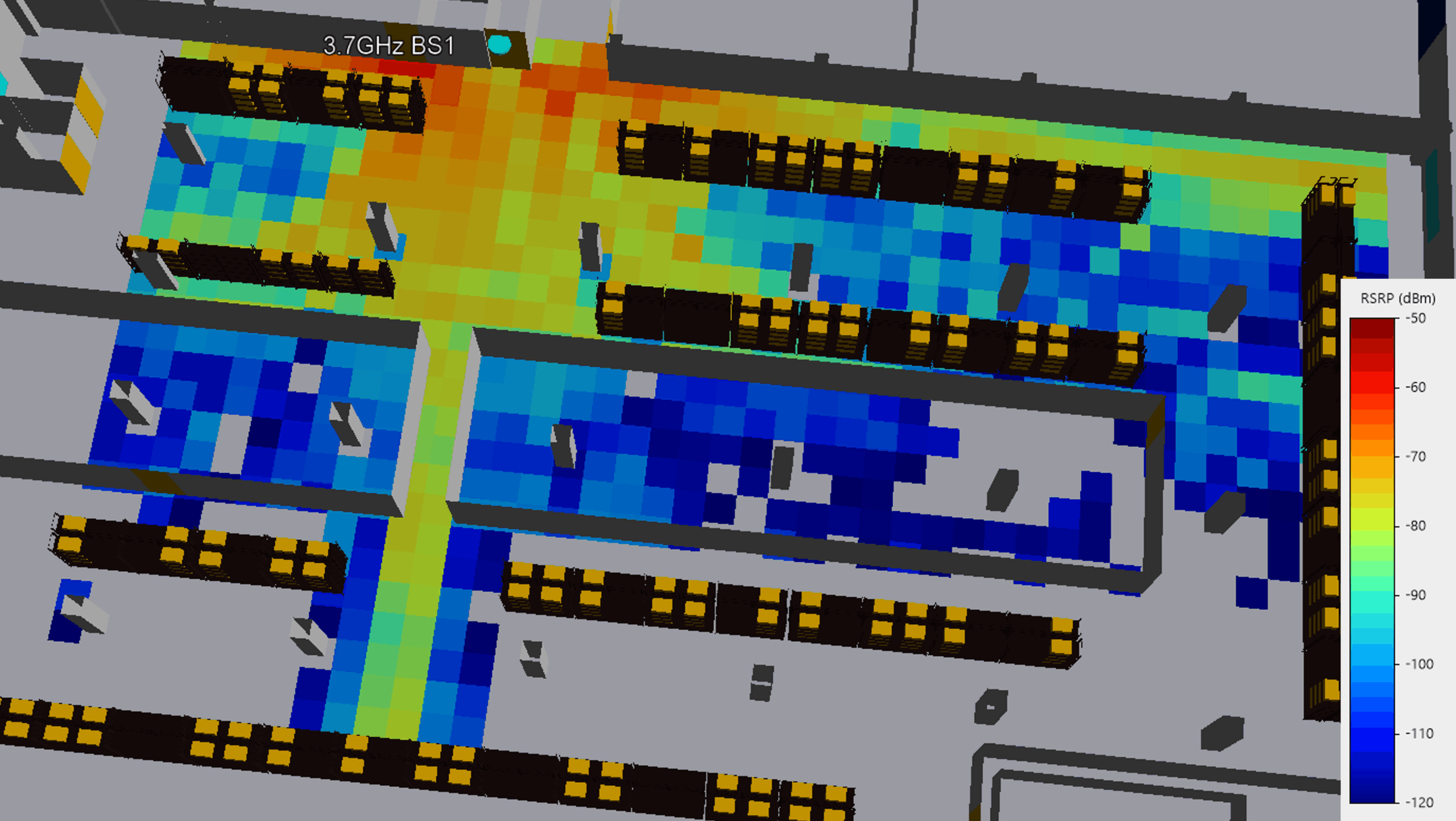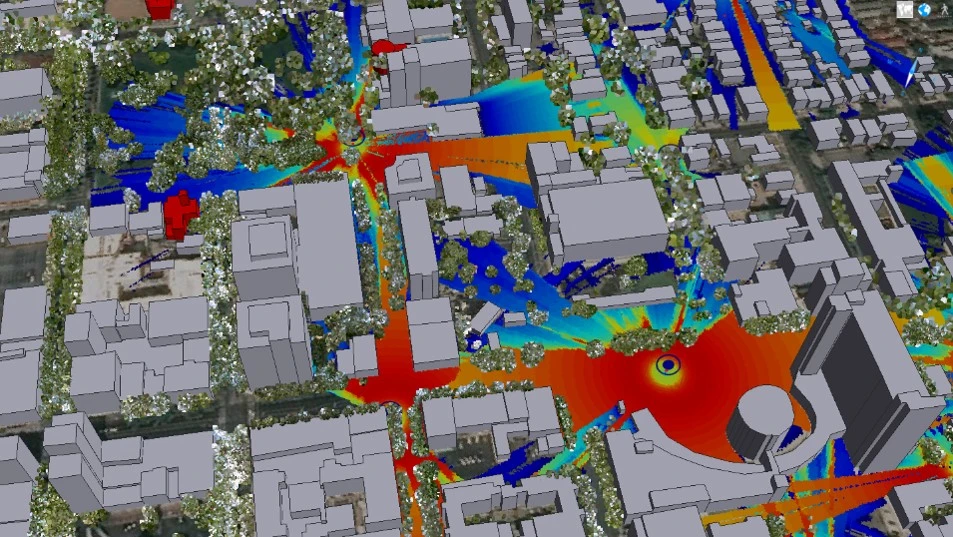This article is a summary of the paper “Reconfigurable Intelligent Surfaces in Factory Environments: Channel Modeling and Use-Case Analysis“ authored by Gurjot Singh Bhatia (Siradel), Yoann Corre (Siradel), Thierry Tenoux (Siradel), and Professor Marco Di Renzo (CNRS, Centrale Supélec & University Paris-Saclay), published in the IEEE Vehicular Technology Magazine.
Context: Recent Advances in Radio Propagation Modeling
This article builds on recent research conducted by Siradel’s teams in collaboration with European academic partners. These studies explored the use of reconfigurable intelligent surfaces (RIS) in complex industrial environments.
The work enabled the integration of an advanced RIS model into the Volcano RT ray-tracing tool to simulate RIS behavior in both near-field and far-field conditions. This approach takes into account practical factors such as phase quantization, wideband response, and indoor multiple interactions.
What is a Reconfigurable Intelligent Surface (RIS)?
A reconfigurable intelligent surface (RIS) is a panel made up of hundreds of cells that can reflect radio waves in a controlled manner. Unlike a simple radio mirror, each cell can adjust the phase of the reflected signal to steer the global radio beam in a desired direction.
RIS operate in a passive or quasi-passive way: they do not amplify the signal, making them an extremely energy-efficient solution. In a factory, for example, they can redirect a 5G signal around a metal machine that would otherwise block the transmission.
Why Are RIS Useful in Industrial Environments?
Factories are typically cluttered radio environments, filled with storage racks, metallic partitions, and complex structures. All of this creates radio shadow zones where signal quality is degraded.
Instead of installing new (and costly) antennas that consume more energy, RIS can be strategically placed between the base station (BS) and underserved areas. These act as intelligent passive relays, redirecting the signal where it is needed most.
Are RIS Effective in a Typical Factory Scenario?
Simulations conducted in a 3D-modeled industrial environment show that RIS can significantly enhance radio coverage, especially in hard-to-reach areas.
- On sub-6 GHz frequencies, properly positioned RIS can noticeably extend coverage, with larger RIS surfaces delivering stronger gains while adapting to environmental constraints such as placement and line-of-sight.
- At mmWave frequencies (e.g., 27 GHz), where signals are highly sensitive to obstacles, RIS provides even greater benefits. They help target specific areas with high-quality signals, mitigate losses caused by obstructions, and complement the existing network.
In demonstration of a factory case study [see article], we observed a 3.7-GHz single-cell coverage extension of 27% due to a 32×32 RIS. The gain obtained at 27 GHz is 47%.
These results highlight the potential of RIS as a versatile solution, offering frequency-dependent gains and serving as an alternative to network densification through additional antennas.
Do RIS Performance Levels Depend on Their reconfiguration’s precision?
Yes, the performance does strongly depend on the capability of the RIS-based network to automatically and optimally adapt the phase shift values for targetted users. In our current work, we consider an optimal linear gradient of the phase over the RIS surface. However, as in real-world scenarios, RIS cells are supposed to adjust their phase in predefined steps, with typically two opposite values in 1-bit reconfiguration, or 4 values in 2-bit reconfiguration. The sensitivity to phase precision levels is found to be relatively moderate.
- A 2-bit configuration offers a good balance between hardware cost and performance (e.g., in our factory case study, 95% of the coverage gain is preserved).
- A 1-bit setup still enables easier implementation nd delivers meaningful improvements (e.g., in our factory case study, 58% of the coverage gain is preserved).
This confirms that practical RIS reconfiguration (with phase quantization) is feasible without major performance trade-offs.
Do RIS Work at Millimeter-Wave (mmWave) Frequencies?
Yes. Tests at mmWave bands confirm that RIS can improve coverage even at high frequencies such as 27 GHz, where signals are highly sensitive to obstacles.
- They help target specific areas with high-quality signals.
- They mitigate losses caused by obstructions and complement the existing network.
This makes RIS a versatile technology for both capacity and coverage enhancement.
What Are the Key Benefits of Siradel Inowave RT Tool?
Siradel has integrated an advanced RIS model into its Siradel Inowave RT prediction tool, allowing:
- 5G coverage simulation in highly complex indoor environments.
- Combination of conventional interactions (reflections, diffractions) and RIS reflection.
- Accurate modeling of near-field propagation effects.
- Evaluation of different phase quantization levels, RIS sizes, and frequency bands.
All with a level of precision that helps real-world network planning analysis and guide decisions.
Want to Test Innovative Solutions for Optimized Industrial Network Design?
Conclusion: Why Are RIS Essential for Industrial 5G?
Recent studies clearly show:
- RIS significantly enhance radio coverage in highly-cluttered industrial sites.
- They are more energy-efficient than simply adding more antennas.
- Even simple configurations are effective enough for meaningful gains.
Reconfigurable intelligent surfaces thus emerge as a concrete solution for deploying private 5G networks tailored to the constraints of modern factories. However, important challenges remain, particularly regarding the large-scale production of RIS and the implementation of dynamic reconfiguration protocols.
In this context, simulation tools provided by Siradel can be valuable to test scenarios involving mobility and generate time-varying radio channels, helping to optimize RIS deployment and operation under realistic industrial conditions.
Ready to Investigate RIS and Deployment Strategies in Complex Environments ?
Siradel supports you in modeling, simulating, and deploying intelligent 5G solutions.
Contact us for a customized study of your radio infrastructure.



